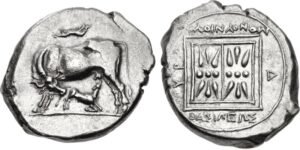Illyrian Coin Symbols and What They Meant to the People Who Struck Them
If you’ve spent any time digging through ancient coin trays — online or in hand — you’ve probably seen some unusual symbols on Illyrian pieces. A cow nursing a calf. A diademed figure. Stars, horses, hunting goddesses. Some of it looks familiar, some of it feels cryptic.
But one thing’s clear: these weren’t just decorations. Every image on an Illyrian coin told a story — about the ruler, the tribe, the gods, or the land they called home.
Here’s a collector’s look at the most common Illyrian coin symbols, what they likely meant, and why they still matter today.
🐄 Cow and Calf — A Signature of Monunius
Let’s start with one of the most recognizable symbols on Illyrian silver: the cow suckling a calf.
You’ll find it on the silver drachms of King Monunius, and it’s one of those designs that makes you pause. It’s not aggressive or royal — it’s tender, grounded, local. Most scholars believe it represents fertility, abundance, or even the nurturing strength of Illyria itself.
👉 When I first saw one of these, I assumed it was a generic pastoral image — but knowing it was chosen to stand for an entire kingdom? That hit different.
👑 Diademed King — Ballaios Shows Who’s Boss
Flip through Ballaios’ bronze coins, and you’ll see his diademed portrait on almost all of them. It’s a subtle but strong claim to kingship, borrowing from the Hellenistic world where the diadem symbolized sovereign rule.
Was Ballaios trying to look like a Greek king? Maybe. Or maybe he was just sending a clear message: “I’m not a local chief. I’m royalty.”
👉 For collectors, a well-struck diadem on a Ballaios bronze is a keeper. It’s not just about the face — it’s about what that headband stood for.
🏹 Artemis and Nike — Not Just Greek Imports
Ballaios’ coins also bring us Artemis (goddess of the hunt) and Nike (goddess of victory). At first glance, it feels like standard Greek iconography. But Illyrians weren’t copying blindly — these deities were likely chosen for specific reasons.
-
Artemis may have symbolized strength, protection, and a tribal hunting culture
-
Nike could’ve been a way to celebrate military victories — or even Ballaios’ rise to power
These figures weren’t random — they had purpose.
🌟 Stars and Stellate Patterns — Tribal Identity?
You’ll find simple star symbols on the reverse of many Illyrian coins — usually geometric, sometimes spiky. We still don’t fully understand what they meant, but possibilities include:
-
Tribal emblems
-
Mint control marks
-
Or maybe celestial protection — a spiritual link to the heavens
👉 One thing’s for sure: they weren’t ornamental fluff. These marks mattered.
🐎 Horses and Riders — Symbols of Prestige
Some regional Illyrian bronzes — especially those possibly tied to Gentius — show standing horses or mounted riders. Considering how important horses were to Illyrian tribes, it’s not surprising.
They might represent:
-
Nobility or warrior class
-
Speed and strength
-
Or perhaps specific tribal leaders
👉 As a collector, I love these coins for how grounded they feel — no gods or myths, just a horse and a name.
🔺 Tripods — Sacred or Strategic?
Occasionally, you’ll find tripods on Illyrian coins, possibly linked to Apollo. They’re rare, and when they do appear, it raises questions: Was this a borrowed Greek religious symbol? A sacred association with power?
Whatever the case, it meant something to the minters — and that’s what makes it fascinating.
Why These Symbols Matter to Us Today
Here’s the thing: Illyrian coin symbols are still being studied. We don’t have all the answers — and that’s exactly what makes collecting these coins exciting.
Each coin is a small puzzle:
-
Why did Monunius pick the cow and calf?
-
Why was Artemis so prominent under Ballaios?
-
What do the stars really mean?
👉 When you collect Illyrian coins, you’re not just buying ancient metal — you’re joining a conversation across 2,000 years, trying to decode what mattered to a people who left no written history of their own.
